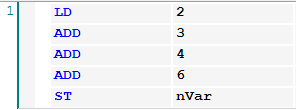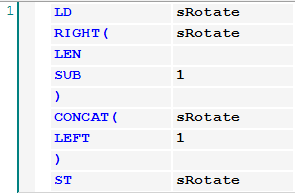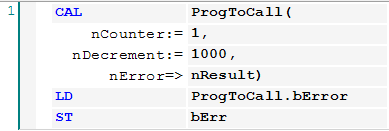Modifiers and Operators in IL
Modifiers:
Modifier | Combined with operator | Description |
|---|---|---|
C | JMP, CAL, RET | The instruction is only executed if the result of the preceding expression is TRUE. |
N | JMPC, CALC, RETC | The instruction is only executed if the result of the preceding expression is FALSE. |
N | otherwise | Negation of the operand (not the accumulator). |
Operators with the possible modifiers:
Operator | N | Meaning | Example |
|---|---|---|---|
LD | N | Loads the (negated) value of the operand into the accumulator. | LD ivar |
ST | N | Stores the (negated) content of the accumulator in the operands. | ST iErg |
S |
| Sets the operand (type BOOL) to TRUE, if the content of the accumulator is TRUE. | S bVar1 |
R |
| Sets the operand (type BOOL) to FALSE, if the content of the accumulator is TRUE. | R bVar1 |
AND | N,( | Bitwise AND of the accumulator value and the (negated) operand | AND bVar2 |
OR | N,( | Bitwise OR of the accumulator value and the (negated) operand | OR xVar |
XOR | N,( | Bitwise, exclusive OR of the accumulator value and the (negated) operand | XOR N,(bVar1,bVar2) |
NOT |
| Bitwise negation of the accumulator value |
|
ADD | ( | Addition of the accumulator value and the operand. The result is written into the accumulator. | ADD ivar1 |
SUB | ( | Subtraction of the operand from the accumulator value. The result is written into the accumulator. | SUB iVar2 |
MUL | ( | Multiplication of the accumulator value and the operand. The result is written into the accumulator. | MUL ivar2 |
DIV | ( | Division of the accumulator value by the operand. The result is written into the accumulator. | DIV 44 |
GT | ( | Checks whether the accumulator value is greater than the value of the operand. The result (BOOL) is written into the accumulator. > | GT 23 |
GE | ( | Checks whether the accumulator value is greater than or equal to the value of the operand. The result (BOOL) is written into the accumulator. | GE iVar2 |
EQ | ( | Checks whether the accumulator value is equal to the value of the operand. The result (BOOL) is written into the accumulator. | EQ iVar2 |
NE | ( | Checks whether the accumulator value is equal to the value of the operand. The result (BOOL) is written into the accumulator. | NE iVar1 |
LE | ( | Checks whether the accumulator value is greater than or equal to the value of the operand. The result (BOOL) is written into the accumulator. | LE 5 |
LT | ( | Checks whether the accumulator value is less than the value of the operand. The result (BOOL) is written into the accumulator. | LT cVar1 |
JMP | CN | Unconditional (conditional) jump to the specified label | JMPN next |
CAL | CN | (Conditional) call of a program or function block (if the accumulator value is TRUE) | CAL prog1 |
RET |
| Exits the block and returns to the calling function block | RET |
RET | C | If the accumulator value is TRUE: Exits the function block and returns to the calling function block | RETC |
RET | CN | If the accumulator value is FALSE: Exits the function block and returns to the calling function block | RETCN |
) |
| Evaluates the deferred operation |
|
Example:

Application | Description | Example |
|---|---|---|
Multiple operands for 1 operator | Possibilities
| Version 1:
Version 2:
|
Complex operands | For a complex operand, specify the opening bracket ( in the first column. Enter the closing bracket in the first column in a separate line after the operand entries for the following lines. | A string is rotated by one character each cycle:
|
Function block call, subroutine call | Column 1: Operator CAL or CALC Column 2: Name of the function block instance or program and opening bracket (. If no parameters follow, the closing bracket ) is entered here. Subsequent lines: Column 1: Parameter name followed by: = for input parameters or => for output parameters Column 2: Parameter value followed by comma, if followed by other parameters. After the last parameter the closing bracket ) is entered. Complex expressions cannot be used here, which is a restriction with regard to the IEC standard. You must assign such constructs to the function block or the program before the call. |
|
Function call | Line 1: Column 1: LD Column 2: Input Variable Line 2: Column 1: Function name column 2: further input parameters, separated by commas. TwinCAT writes the return value to the accumulator. Line 3: Column 1: ST column 2: Variable to which the return value is written |
|
Action call | Like function block or program call. The action name is appended to the FB instance or program name. |
|
Jump | Column 1: Operator JMP or JMPC. Column 2: Name of the label of the destination network. For an unconditional jump, the preceding instruction sequence must end with one of the following commands: ST,STN, S, R, CAL, RET, JMP For a conditional jump, the execution depends on the loaded value. |
|
See also:






